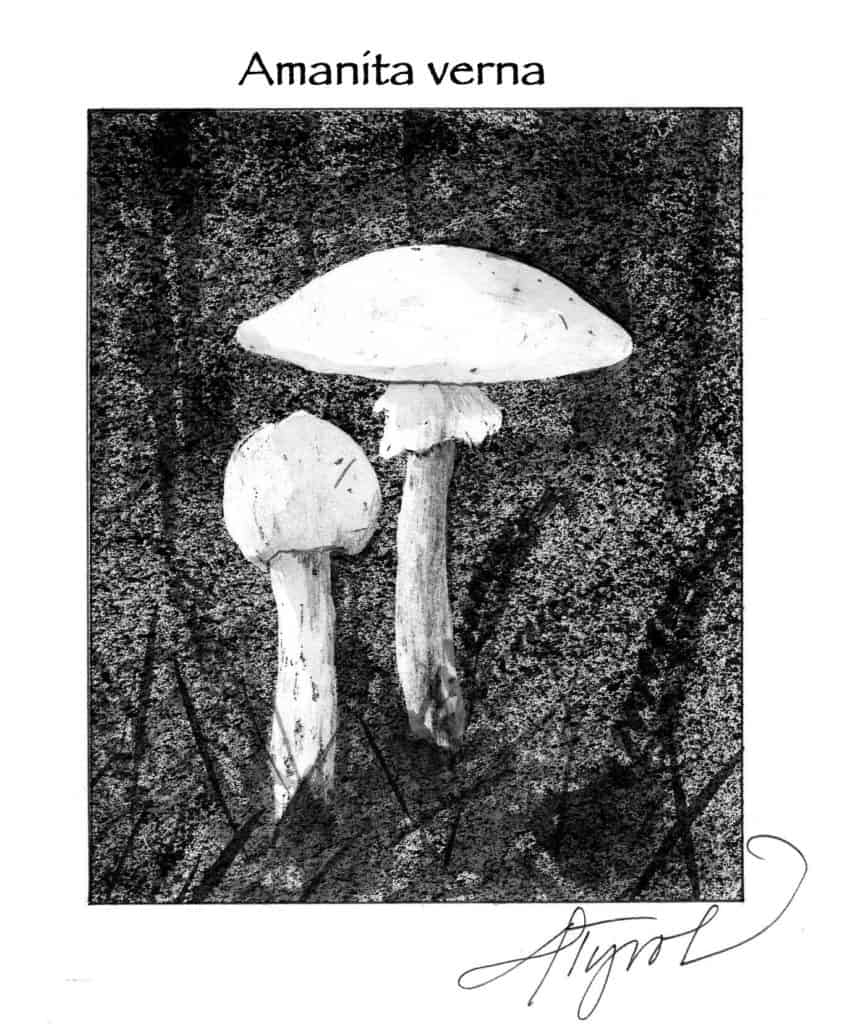
By Susan Shea
A walk in the woods during fall is likely to reveal an array of forest fungi. Ranging from delicate, tan mini-umbrellas to fleshy, white softballs to foot-long, orange-yellow shelves growing out of rotten logs, they come in a variety of colors, shapes, and sizes. Fungi are critical to the health of the forest, decomposing woody debris and helping trees obtain required nutrients.
Fungi are neither plant nor animal, and biologists place them in their own kingdom. The mushroom we see is only a small part of the fungus. Mushrooms are the fruit of a fungus, temporary structures intended to disperse spores. Most of a fungus’ body, or mycelium, is hidden underground or inside the dead tree or fallen log upon which it is growing. The mycelium is made up of a network of threadlike filaments, called hyphae, which grow through soil or wood, secreting acids and enzymes that break down the substrate, making it easier for the fungus to absorb nutrients. If you roll over a few rotten logs, you can often see a spider-like web of white or yellow mycelia beneath.
Many fungi play a vital role as decomposers in the forest. As they feed on leaf litter and dead trees, they convert this debris to humus, releasing and recycling nutrients back into the soil so new trees can grow. Only fungi and some bacteria are capable of breaking down lignin, the component of wood and other plants which imparts rigidity. The turkey tail fungus, with its concentric bands of brown, rust, and gray, is an example of a wood-decaying fungus.
Other fungi are parasitic, growing on living trees, and may eventually kill their host. In an interesting relationship, the golden-colored honey mushroom both parasitizes living trees and then decomposes them, while the aborted entoloma fungus in turn parasitizes honey mushrooms.
Some species of fungi, such as truffles and the giant puffball, greatly benefit trees and other plants by growing on their roots as symbiotic partners. This interwoven network of mycorrhizal fungi can soak up water and nutrients over a large area, helping a tree obtain many essential minerals. In exchange, the tree provides the fungi with energy-rich sugars it manufactures through photosynthesis.
Reproduction in fungi is varied and complex. Many fungi can reproduce asexually, for example when fragments of hyphae break off and grow new colonies, as well as sexually. During sexual reproduction, the mycelium of a fungus merges with a compatible mating type of the same species underground (fungi do not have distinct genders). New hyphae are generated, and when temperatures and soil moisture are right, they develop fruiting bodies – or mushrooms – that erupt above ground.
Young mushrooms are known as buttons or eggs. In many species, as the egg grows, the cap breaks through the egg’s veil, the stalk lengthens, and the cap opens like an umbrella. The expanding cap breaks the secondary veil protecting the gills. Remnants of this veil form a ring or annulus visible around the stem in some mushrooms. Thousands to billions of spores ripen in rows of gills on the underside of the mushroom’s cap, and when ready, are disseminated by wind, water, or by hitching a ride on an animal. Only a small percentage will land in a spot suitable for germination and grow into another mycelium.
Not all mushrooms have gills, however; for example, the boletes and the wood-decaying bracket and conk fungi bear their spores in elongated tubes, while the spores of hedgehog mushrooms develop on spines.
Fungal fruit is an important food for wildlife. Chipmunks, mice, squirrels, skunks, deer, and grouse all eat mushrooms. Red squirrels will even dry and store mushrooms in the nooks and crannies of tree trunks and branches for later use. Human foragers, however, are wise to exercise caution if they plan to consume mushrooms.
“There are quite a few mushrooms that could kill you,” said Dave Muska, a naturalist and educator at the North Branch Nature Center in Vermont. Muska and the students in his mycology class identified 60 species of fungi in the woods one weekend this fall, including many in the Amanita family, which includes the most poisonous mushrooms. He recommends taking a class or accompanying an experienced forager before eating any fungus.
Or you can stay away from dining on wild fungi and simply enjoy their beauty, uniqueness, and the key role they play in a healthy forest.
Susan Shea is a naturalist, writer, and conservationist who lives in Brookfield, Vermont. Illustration by Adelaide Murphy Tyrol. The Outside Story is assigned and edited by Northern Woodlands magazine and sponsored by the Wellborn Ecology Fund of the New Hampshire Charitable Foundation: nhcf.org.




